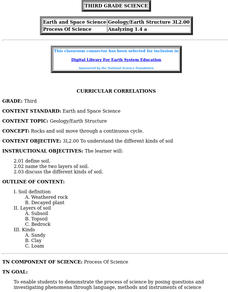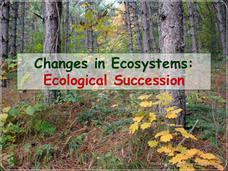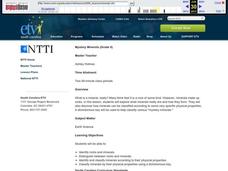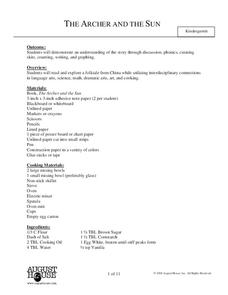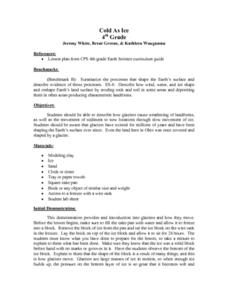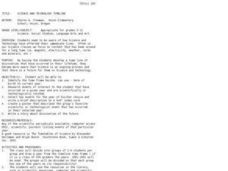Curated OER
Cloze Procedure for Fever 1793 by Laurie Halse Anderson
Is your class ready to read Laurie Halse Anderson's Fever 1793? Before they begin this historical novel, have them complete this cloze procedure to determine if it is at the correct reading level. The directions for introducing a cloze...
Curated OER
Exploring Caves
Students explain why many caves have become National Parks. They determine that caves provide shelter from enemies, and from bad weather in the summer or the winter, and provide certain mineral resources. They discover that ancient art...
Curated OER
Curricular Correlations
An interesting lesson plan on different types of soils is here for you. In it, learners discuss what soil is, and consider three piles of soil - clay, sand, and loam. During the rest of the lesson plan, third graders discover all sorts...
Curated OER
Quartz
In this quartz worksheet, students read about the chemical structure and properties of quartz and its commercial applications. Then, students complete 7 short answer questions.
Curated OER
Dark Days
Fourth graders investigate the impacts of erosion. For this Science lesson, 4th graders determine connections between plants and soil erosion. Students examine the historical implications of erosion.
Curated OER
Soil and Volcanoes
In this soil and volcano worksheet, students read information about soil and volcanoes and answer questions provided. Students also build model of a volcano and participate in soil activities.
Curated OER
Layering the Soil
Learners study and classify soil. In this soil science lesson plan, students classify soil by texture and size and study soil horizons. Learners label the soil types with their specific soil horizon and learn about permafrost. Students...
Curated OER
Change Agents
Third graders experiment with three erosive change agents. They do an observation log, which they present to the class through a song, poem or skit.
Curated OER
SCRUMPTIOUS SOIL
Students engage in investigations that lead to the discovery that earth materials consist of rocks, soils, water, and air. They build models of soil profiles, using breakfast cereal and other edible materials. They observe how water...
Curated OER
Acid Rain
Students understand the dynamics of acid rain and its impact on the living and non-living environment. They hypothesize how acid rain affects water pH levels in two lake systems with differing watershed features.
Curated OER
Bank On It! Antarctica
In this vocabulary worksheet, students read an informational paragraph about Antarctica. Students then fill in the 17 blanks with words from the word bank.
Curated OER
Relative Age Dating
Modeling dough and paper cutouts in science class? Learn about how relative age dating concepts, like the Law of Superposition and cross-cutting relationships, can be used to describe the formation of sedimentary layers.
Biology Junction
Changes in Ecosystems: Ecological Succession
Can an area with no soil turn into a forest? Scholars learn about the process of ecological succession using an interesting presentation. It covers both primary and secondary succession in the building of new ecosystems.
Science 4 Inquiry
Let's Get Moving
Rivers top the list of causes of erosion over time. Scholars experiment with wind, water, and ice reshaping sand. They connect the simulations facts about erosion and deposition to understand unique landforms such as the Grand Canyon and...
Curated OER
Forces That Shape the Earth: Wind, Water and Erosion
In this forces of nature learning exercise, students read a 2 page article on the forces of nature and answer 4 detailed comprehension questions about the forces of nature on Earth.
Curated OER
Mineral Mixtures
In this science worksheet, students use basic scientific concepts to complete the series of puzzles that are intended to increase science literacy for classifying types of rocks and minerals.
Curated OER
SOIL
Second graders name the various materials that comprise soil, including weathered rock and other organic matter; and explain that soils differ in their color, texture, capacity to retain water, and ability to support the growth of many...
Curated OER
Mystery Minerals
Students minerals and how they form. They investigate the classification of minerals according to physical properties. Students watch a video about mineral characteristics. In groups, students participate in hands-on activities and...
Curated OER
The Archer and the Sun
Students listen to The Archer and the Sun and participate in interdisciplinary activities related to the book. In this Archer and the Sun instructional activity, students discuss sun and weather and create a graph of the weather they...
Curated OER
The Earth Around Us: Air, Water & Soil
Second graders explore erosion and find the factors effecting erosion of hillsides. In this erosion lesson, 2nd graders experiment by creating a hillside and simulating rain. Students discuss and record their results on...
Curated OER
Cold As Ice
Fourth graders investigate how glaciers cause the weathering of landforms. They observe a brick that has been placed on a frozen slab of ice, and discuss the results, comparing them to the movements of a glacier. In small groups, they...
Curated OER
The Contest Between the Sun and the Wind
First graders read and explore the folktale, The Contest Between the Sun and the Wind. In this folktale lesson, 1st graders read the tale and describe the sun. There are several interdisciplinary extensions included: students illustrate...
Curated OER
Moon Features Activity
In this moon worksheet, students answer questions about the lunar surface and identify the features of the moon on a moon map. They include craters, bays, mountains, seas, oceans and craters.
Curated OER
Science and Technology Timeline
Learners develop a time line of discoveries that have occurred in their lifetime. In this time line lesson plan, students research scientifically or technologically related events of interest to them, write a brief description on a 4x6"...


